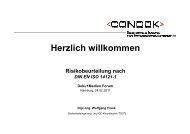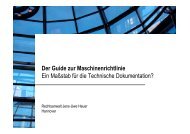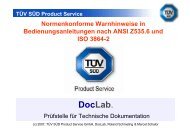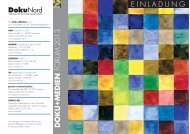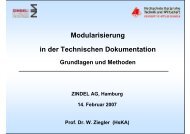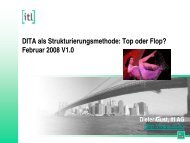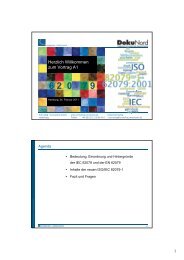Von Büchern zu Informationsschnippseln und wieder zurück - Zindel AG
Von Büchern zu Informationsschnippseln und wieder zurück - Zindel AG
Von Büchern zu Informationsschnippseln und wieder zurück - Zindel AG
Erfolgreiche ePaper selbst erstellen
Machen Sie aus Ihren PDF Publikationen ein blätterbares Flipbook mit unserer einzigartigen Google optimierten e-Paper Software.
27.02.2008<br />
<strong>Von</strong> <strong>Büchern</strong><br />
<strong>zu</strong> <strong>Informationsschnippseln</strong> <strong>und</strong> <strong>wieder</strong> <strong>zu</strong>rück V1.0<br />
Dieter Gust, itl <strong>AG</strong><br />
http://www.itl.eu
Wer spricht da?<br />
Dieter Gust<br />
22 Jahre im Bereich Technische<br />
Dokumentation tätig<br />
Technischer Redakteur<br />
Dozent für technische Dokumentation<br />
Trainer für Publishingsysteme<br />
FrameMaker + Word<br />
(Ventura, PageMaker)<br />
Spezialist für PDF-Produktionen<br />
Information Architect:<br />
Desktop Publishing,<br />
Content Management,<br />
Überset<strong>zu</strong>ngsprozesse<br />
Prokurist bei itl<br />
27.02.2008 <strong>Von</strong> <strong>Büchern</strong> <strong>zu</strong> <strong>Informationsschnippseln</strong> <strong>und</strong> <strong>wieder</strong> <strong>zu</strong>rück Version 1.0 Februar 2008<br />
2
Neue Anforderungen in der technischen Dokumentation<br />
„Writing for reuse“: Definition von<br />
Informationsmodulen für eine<br />
Mehrfachverwendung<br />
Single-Source-Cross Media:<br />
In eine Quelle schreiben <strong>und</strong><br />
daraus Informationen für<br />
verschiedene Medien erzeugen.<br />
„Multithreading“ für<br />
Überset<strong>zu</strong>ngen, um<br />
Überset<strong>zu</strong>ngen bereits vor<br />
Fertigstellung einer<br />
Dokumentation starten <strong>zu</strong> können.<br />
Immer komplexere Produkte<br />
verlangen immer umfassendere<br />
Erklärungen. Damit eine<br />
Dokumentation<br />
„nachschlagefre<strong>und</strong>lich“ bleibt,<br />
muss Information muss sich aus<br />
isolierten Informationseinheiten<br />
<strong>zu</strong>sammensetzen<br />
(Lexikonprinzip).<br />
Es bleibt weniger Zeit für mehr<br />
Text<br />
Die Topic-Orientierung bietet für die neuen Anforderungen<br />
offenbar den geeigneten Ansatz.<br />
27.02.2008 <strong>Von</strong> <strong>Büchern</strong> <strong>zu</strong> <strong>Informationsschnippseln</strong> <strong>und</strong> <strong>wieder</strong> <strong>zu</strong>rück Version 1.0 Februar 2008<br />
3
Informationsschnippsel noch ganz ohne Topic-Ideologie (1)…<br />
Wie erreicht man es, weniger <strong>zu</strong><br />
schreiben bei gleich bleibender<br />
Informationsmenge?<br />
] Identifizieren Sie die Eigentümer<br />
der jeweiligen Informationen<br />
] Überlegen sie sich einen<br />
automatischen Importprozess für<br />
diese Informationen in Ihrem<br />
Informationsprodukt (z. B.<br />
Dokument)<br />
Daten aus der Projektdefinition<br />
Standardtext<br />
27.02.2008 <strong>Von</strong> <strong>Büchern</strong> <strong>zu</strong> <strong>Informationsschnippseln</strong> <strong>und</strong> <strong>wieder</strong> <strong>zu</strong>rück Version 1.0 Februar 2008<br />
4
Informationsschnippsel noch ganz ohne Topic-Ideologie (2)…<br />
Wie erreicht man es, weniger <strong>zu</strong><br />
schreiben bei gleich bleibender<br />
Informationsmenge?<br />
] Identifizieren Sie die Eigentümer<br />
der jeweiligen Informationen<br />
] Überlegen sie sich einen<br />
automatischen Importprozess für<br />
diese Informationen in Ihrem<br />
Informationsprodukt (z. B.<br />
Dokument)<br />
Standardtext<br />
Daten aus der Entwicklung<br />
27.02.2008 <strong>Von</strong> <strong>Büchern</strong> <strong>zu</strong> <strong>Informationsschnippseln</strong> <strong>und</strong> <strong>wieder</strong> <strong>zu</strong>rück Version 1.0 Februar 2008<br />
5
Topic-Orientierung/Modularisierung ist kein Selbstzweck<br />
(2) Welche Granularität ist geeignet?<br />
Flexibilität<br />
für Wiederverwendung<br />
Verwaltungsaufwand<br />
Eine fiktive<br />
optimale Stelle<br />
Red<strong>und</strong>anz<br />
bei Mehrfachverwendung<br />
Modulgröße: Datum, Wort, Satz, Absatz, Topic, Abschnitt, Kapitel<br />
27.02.2008 <strong>Von</strong> <strong>Büchern</strong> <strong>zu</strong> <strong>Informationsschnippseln</strong> <strong>und</strong> <strong>wieder</strong> <strong>zu</strong>rück Version 1.0 Februar 2008<br />
6
Weitere Informationseinheiten finden –<br />
nach Bedarf oder aus Prinzip?<br />
Informationseinheiten nur nach<br />
Bedarf!<br />
] Überlegen Sie, welche (Teil-)<br />
Informationen nicht dokument-/<br />
gerätespezifisch sind<br />
] Überlegen Sie welche<br />
Informationseinheiten einen<br />
Master (Obermenge) für<br />
Dokumentvarianten sein können,<br />
die durch eine „Filterung“<br />
dokumentspezifisch gemacht<br />
werden können.<br />
] Nutzen Sie alle Funktionen von<br />
FrameMaker (oder analoge<br />
Funktionen bei Word):<br />
Variablen, Bedingter Text,<br />
Einteilung in Dateien, Text-<br />
Einschübe…<br />
Informationseinheiten aus Prinzip!<br />
] Sie wollen es nicht anders, Sie<br />
wollen die Topicisierung…<br />
] Ob Sie dann noch<br />
dokumentorientiert arbeiten<br />
dürfen oder können, wage ich <strong>zu</strong><br />
bezweifeln.<br />
27.02.2008 <strong>Von</strong> <strong>Büchern</strong> <strong>zu</strong> <strong>Informationsschnippseln</strong> <strong>und</strong> <strong>wieder</strong> <strong>zu</strong>rück Version 1.0 Februar 2008<br />
7
<strong>Von</strong> <strong>Büchern</strong> <strong>zu</strong> Topics: „Topicisierung“<br />
27.02.2008 <strong>Von</strong> <strong>Büchern</strong> <strong>zu</strong> <strong>Informationsschnippseln</strong> <strong>und</strong> <strong>wieder</strong> <strong>zu</strong>rück Version 1.0 Februar 2008<br />
8
Schreibmethodiken: Buch-Orientierung versus Topic-Orientierung<br />
Buch-Orientierung: Top-down<br />
] Buch<br />
] Kapitel<br />
] Abschnitt<br />
] Unterabschnitt<br />
] „visuelle Infoeinheit“<br />
] Absatz<br />
Terminologie<br />
Tendenz <strong>zu</strong> expliziten oder<br />
impliziten Verweisen der<br />
folgenden Art<br />
] „im folgenden“<br />
] „weiter unten“ /„weiter oben“<br />
Topic-Orientierung: Bottom-up<br />
] Buch<br />
] Kapitel<br />
] Topic Group /Abschnitt<br />
] Topic<br />
] Sub-Topic / Section / Block<br />
] Absatz<br />
Separates Linkkonzept<br />
Verwandte Topics, siehe auch<br />
27.02.2008 <strong>Von</strong> <strong>Büchern</strong> <strong>zu</strong> <strong>Informationsschnippseln</strong> <strong>und</strong> <strong>wieder</strong> <strong>zu</strong>rück Version 1.0 Februar 2008<br />
Terminologie<br />
9
Beispiel<br />
Dokumenthierarchie Top-Down (1)<br />
27.02.2008 <strong>Von</strong> <strong>Büchern</strong> <strong>zu</strong> <strong>Informationsschnippseln</strong> <strong>und</strong> <strong>wieder</strong> <strong>zu</strong>rück Version 1.0 Februar 2008<br />
10
Was ist ein Topic?<br />
Ein Topic ist ein Stück<br />
Information, der eine Frage<br />
beantwortet<br />
] Wie tue ich …<br />
] Was ist…<br />
] Wie kann ich eine Information<br />
identifizieren <strong>und</strong> einzelne Daten<br />
nachschlagen<br />
Generell: Ein Topic erfüllt eine<br />
bestimmte Nut<strong>zu</strong>ngs-Funktion:<br />
[ Informieren (Konzept-Topic)<br />
[ Nachschlagen (Referenz-Topic)<br />
[ Anweisen Prozedur-Topic)<br />
[ Weitere Nut<strong>zu</strong>ngsfunktionen für<br />
Topics: Juristische Absicherung,<br />
Lernschritt, Beispiel , FAQ…<br />
Ein Topic hat einen Titel<br />
(eine Überschrift)<br />
Ein Topic ist in sich<br />
abgeschlossen. Er macht Sinn…<br />
] …ohne jeden Kontext<br />
] …in beliebigem Kontext<br />
Ein Topic enthält keinen<br />
verbindenden Text. Es ist kein<br />
„Kleber“ nötig, um verschiedenen<br />
Topics <strong>zu</strong> verbinden.<br />
] Es gibt verschiedenen Meinungen<br />
über „Kleber“ <strong>und</strong><br />
„Verbindungstexte“<br />
] http://dita.xml.org/node/1410<br />
] http://dita.xml.org/node/1413<br />
27.02.2008 <strong>Von</strong> <strong>Büchern</strong> <strong>zu</strong> <strong>Informationsschnippseln</strong> <strong>und</strong> <strong>wieder</strong> <strong>zu</strong>rück Version 1.0 Februar 2008<br />
11
Drei generische Topic-Typen<br />
Die Unterscheidung der Topic-Typen ist von Nut<strong>zu</strong>ngskategorien abgeleitet.<br />
Nut<strong>zu</strong>ngskategorien = Klassifikation der Dokumentationsnut<strong>zu</strong>ng<br />
Topic<br />
Sich Anweisen lassen Lernen durch Lesen Nachschlagen<br />
Aufgabe (Task)<br />
] Enthält einen<br />
Arbeitsschritt<br />
oder eine<br />
nummerierte<br />
Sequenz<br />
von Schritten.<br />
Konzept (Concept)<br />
] Beschreibt etwas in<br />
vollen Sätzen.<br />
27.02.2008 <strong>Von</strong> <strong>Büchern</strong> <strong>zu</strong> <strong>Informationsschnippseln</strong> <strong>und</strong> <strong>wieder</strong> <strong>zu</strong>rück Version 1.0 Februar 2008<br />
Referenz (Reference)<br />
] Stellt eine<br />
Nachschlage-Liste<br />
oder -Tabelle dar<br />
<strong>zu</strong>r schnellen<br />
Identifikation von<br />
Begriffen oder<br />
Daten.<br />
12
Generische Topic-Typen. Beispiel: Task<br />
27.02.2008 <strong>Von</strong> <strong>Büchern</strong> <strong>zu</strong> <strong>Informationsschnippseln</strong> <strong>und</strong> <strong>wieder</strong> <strong>zu</strong>rück Version 1.0 Februar 2008<br />
13
Generische Topic-Typen. Beispiel: Konzept<br />
27.02.2008 <strong>Von</strong> <strong>Büchern</strong> <strong>zu</strong> <strong>Informationsschnippseln</strong> <strong>und</strong> <strong>wieder</strong> <strong>zu</strong>rück Version 1.0 Februar 2008<br />
14
Generische Topic-Typen.<br />
Laut Source „Concept“. Warum nicht Reference?<br />
27.02.2008 <strong>Von</strong> <strong>Büchern</strong> <strong>zu</strong> <strong>Informationsschnippseln</strong> <strong>und</strong> <strong>wieder</strong> <strong>zu</strong>rück Version 1.0 Februar 2008<br />
15
Topic-orientiertes Schreiben: Prinzipien (1)<br />
Betitelungsprinzip (Labeling)<br />
] Die Überschrift definiert eine<br />
Frage oder eine Antwort, welche<br />
ein Topic im Detail beschreibt.<br />
Kettenprinzip<br />
] Alle Begriffe im Topic sind in<br />
einer logischen <strong>und</strong> strukturell<br />
sinnvollen Reihenfolge<br />
aufgeführt.<br />
] Topics können in bestimmten<br />
Sequenzen in eine logische<br />
Reihenfolge gebracht werden<br />
(<strong>zu</strong>mindest wenn sie als Buch<br />
gedruckt werden ☺).<br />
Blockprinzip<br />
] Die Information innerhalb eines<br />
Topics ist total in sich<br />
geschlossen. Es gibt keine<br />
sprachlogische Referenz auf<br />
andere Topics (‘wie vorher<br />
beschreiben’, etc.)<br />
Verweisprinzip<br />
] Ein Topic kann natürlich<br />
Querverweise enthalten, <strong>und</strong><br />
zwar vor<strong>zu</strong>gsweise am Ende<br />
eines Topics, nach der<br />
Überschrift „Weitere<br />
Informationen“ oder<br />
„Querverweise“.<br />
27.02.2008 <strong>Von</strong> <strong>Büchern</strong> <strong>zu</strong> <strong>Informationsschnippseln</strong> <strong>und</strong> <strong>wieder</strong> <strong>zu</strong>rück Version 1.0 Februar 2008<br />
16
Topic-orientiertes Schreiben: Prinzipien (2)<br />
Topic-interne<br />
Strukturierungsprinzipien sind<br />
abhängig von der jeweils<br />
implementierten Technologie.<br />
Beispiel DITA:<br />
] Sections, als Einteilung im Topic<br />
(keine Rekursion!)<br />
] Topic im Topic (Rekursion),<br />
außerhalb des Body-Elements<br />
] Die Rekursion von<br />
Strukturelementen (Topic<br />
innerhalb eines Topics, sind zwar<br />
erlaubt, aber laut User Guide<br />
nicht erwünscht.<br />
Die Gesamtstrukturierung<br />
(= das klassische TOC) wird<br />
separat <strong>und</strong> unabhängig von den<br />
Topics definiert.<br />
27.02.2008 <strong>Von</strong> <strong>Büchern</strong> <strong>zu</strong> <strong>Informationsschnippseln</strong> <strong>und</strong> <strong>wieder</strong> <strong>zu</strong>rück Version 1.0 Februar 2008<br />
17
RoboHelp der Klassiker für Online Topics<br />
Beziehung zwischen Topics <strong>und</strong> Buchstruktur<br />
27.02.2008 <strong>Von</strong> <strong>Büchern</strong> <strong>zu</strong> <strong>Informationsschnippseln</strong> <strong>und</strong> <strong>wieder</strong> <strong>zu</strong>rück Version 1.0 Februar 2008<br />
18
Beziehung zwischen Kapiteln, Abschnitten <strong>und</strong> Topics<br />
<strong>Von</strong> <strong>Büchern</strong> <strong>zu</strong> Topics<br />
] Informationseinheiten (=Topics)<br />
identifizieren durch Scannen der<br />
expliziten Überschriften<br />
] Prüfen, ob bei einer<br />
Informationseinheit offensichtlich<br />
die Überschrift fehlt.<br />
] Navigationsüberschriften von<br />
Topic-Überschriften absondern.<br />
] Die identifizierten Topics<br />
innerhalb der Kapitel sich als<br />
isolierte Topics vorstellen, ohne<br />
hierarchische Beziehung<br />
<strong>zu</strong>einander!<br />
Tipp: Stellen Sie sich generierte,<br />
einzelne HTML-Seiten vor.<br />
Topics als isolierte Einheiten<br />
] „Beschreibt der Titel exakt, was<br />
der Inhalt des Topics ist?“<br />
] „Unterscheidet der Titel diesen<br />
Topic von den anderen…?“<br />
] Ist der Topic in sich<br />
abgeschlossen?<br />
Quelle “Authoring DITA content”,<br />
by Dennis Bockus, Michael<br />
Priestley IBM<br />
] Muss der Topic vervollständigt<br />
werden durch Referenzen auf<br />
andere Topics?<br />
] Müssen Topics umgeschrieben<br />
werden mit Blick auf die 3<br />
generischen Topic-Typen?<br />
27.02.2008 <strong>Von</strong> <strong>Büchern</strong> <strong>zu</strong> <strong>Informationsschnippseln</strong> <strong>und</strong> <strong>wieder</strong> <strong>zu</strong>rück Version 1.0 Februar 2008<br />
19
Topics identifizieren – Beispiel (1)<br />
27.02.2008 <strong>Von</strong> <strong>Büchern</strong> <strong>zu</strong> <strong>Informationsschnippseln</strong> <strong>und</strong> <strong>wieder</strong> <strong>zu</strong>rück Version 1.0 Februar 2008<br />
20
Concept<br />
Topic<br />
eference<br />
Topic<br />
Task<br />
Topic<br />
(Sub<br />
Topic?)<br />
Topics identifizieren – Beispiel (2)<br />
27.02.2008 <strong>Von</strong> <strong>Büchern</strong> <strong>zu</strong> <strong>Informationsschnippseln</strong> <strong>und</strong> <strong>wieder</strong> <strong>zu</strong>rück Version 1.0 Februar 2008<br />
21
Topics identifizieren – wie geht das (3)?<br />
27.02.2008 <strong>Von</strong> <strong>Büchern</strong> <strong>zu</strong> <strong>Informationsschnippseln</strong> <strong>und</strong> <strong>wieder</strong> <strong>zu</strong>rück Version 1.0 Februar 2008<br />
22
Topic-orientiertes Schreiben – Menschen mit Pioniergeist<br />
Jakob Nielsen<br />
Robert E.Horn<br />
useit<br />
Information Mapping<br />
William Horton<br />
Writing Online Documentation<br />
Cheryl Lockett Zubak<br />
President of Work Write<br />
Mary Deaton<br />
Ann Rockley<br />
Unified Content Strategy<br />
Norman Walsh<br />
Father of DocBook<br />
DON Day, IBM<br />
DITA Architect<br />
27.02.2008 <strong>Von</strong> <strong>Büchern</strong> <strong>zu</strong> <strong>Informationsschnippseln</strong> <strong>und</strong> <strong>wieder</strong> <strong>zu</strong>rück Version 1.0 Februar 2008<br />
JoAnn T. Hackos<br />
Comtech<br />
DITA Oasis Member<br />
Michael Priestley,<br />
IBM<br />
DITA Architect<br />
23
Methodiken für ein Topic-orientiertes Schreiben<br />
Information Mapping<br />
DITA<br />
Funktionsdesign<br />
Klassenmodell (Sissi Closs)<br />
Generischer Topic Ansatz aus der<br />
Definition von Hilfeinformationen<br />
ISD = Begriff von itl<br />
Informationsstrukturdesign<br />
] Keine neue Religion sondern:<br />
] Zweckorientierer Design-Ansatz:<br />
PentaQuest + Prozess-Design<br />
] Nut<strong>zu</strong>ng vorhandener<br />
Methodiken. Ergän<strong>zu</strong>ng um „neue<br />
Begriffe“ nur soweit sinnvoll<br />
27.02.2008 <strong>Von</strong> <strong>Büchern</strong> <strong>zu</strong> <strong>Informationsschnippseln</strong> <strong>und</strong> <strong>wieder</strong> <strong>zu</strong>rück Version 1.0 Februar 2008<br />
24
Information Mapping: A Remapped Document Example<br />
Map Title<br />
Block Titles<br />
27.02.2008 <strong>Von</strong> <strong>Büchern</strong> <strong>zu</strong> <strong>Informationsschnippseln</strong> <strong>und</strong> <strong>wieder</strong> <strong>zu</strong>rück Version 1.0 Februar 2008<br />
25
Information Mapping<br />
Einführung neuer<br />
Informationseinheiten<br />
] Block <strong>und</strong> Map<br />
7 Prinzipien<br />
] Gliederungsprinzip<br />
] Relevanzprinzip<br />
] Betitelungsprinzip<br />
] Einheitlichkeitsprinzip<br />
] Gleichwertigkeitsprinzip für<br />
Infoelemente Grafik, Bilder, Text<br />
] Prinzip der Verfügbarkeit von<br />
Einzelheiten: Info dort wo benötigt<br />
] Prinzip der systematischen<br />
Gliederung <strong>und</strong> Betitelung:<br />
5–7 Sätze je Block<br />
7+/-2 Blöcke je Map<br />
7 Informationsarten (Map-Arten) nach<br />
Information Mapping®:<br />
] Prozeduren: Wie gehe ich vor?<br />
] Prozesse: Wie funktioniert das?<br />
] Strukturen: Wie sieht es aus? Wie ist<br />
es aufgebaut?<br />
] Begriffe: Was ist es?<br />
] Prinzipien: Was muss ich tun? Was<br />
muss ich beachten?<br />
] Fakten: Was sind die Daten?<br />
] Klassifikationen: Welche Arten gibt<br />
es?<br />
] … sowie Kombinationen aus Map-<br />
Arten<br />
27.02.2008 <strong>Von</strong> <strong>Büchern</strong> <strong>zu</strong> <strong>Informationsschnippseln</strong> <strong>und</strong> <strong>wieder</strong> <strong>zu</strong>rück Version 1.0 Februar 2008<br />
26
DITA Darwin Information Typing Architecture<br />
Darwin<br />
] based on principles of<br />
inheritance and specialization<br />
Information Typing<br />
] supports topic-based<br />
methodologies<br />
Architecture<br />
http://dita-ot.sourceforge.net/<br />
] expresses design principles for<br />
creating and delivering<br />
information-typed topics<br />
27.02.2008 <strong>Von</strong> <strong>Büchern</strong> <strong>zu</strong> <strong>Informationsschnippseln</strong> <strong>und</strong> <strong>wieder</strong> <strong>zu</strong>rück Version 1.0 Februar 2008<br />
27
Why DITA?<br />
“DITA was created based on best<br />
practices in technical authoring<br />
such as task orientation,<br />
chunking, information typing, and<br />
minimalism.”<br />
] Michael Priestley, IBM Canada<br />
“I see the DITA model as<br />
recommending better practices in<br />
the industry. The strength of the<br />
model is not in the technology but<br />
in the conceptualization of best<br />
practices behind it.”<br />
] Dr. JoAnn Hackos<br />
“I think the topic-oriented<br />
authoring paradigm is DITA's<br />
outstanding feature. It's great<br />
because it attacks one of the<br />
hardest problems of writing<br />
reusable documentation: one of<br />
the non-technical problems.”<br />
] Norman Walsh<br />
27.02.2008 <strong>Von</strong> <strong>Büchern</strong> <strong>zu</strong> <strong>Informationsschnippseln</strong> <strong>und</strong> <strong>wieder</strong> <strong>zu</strong>rück Version 1.0 Februar 2008<br />
28
DITA Standard Topic-Typen <strong>und</strong> Spezialisierung<br />
Jeder Topic gehört <strong>zu</strong> einem<br />
bestimmten Informationstyp<br />
Allgemeiner Topic<br />
Concept-Topic<br />
(Begriffserklärungen)<br />
] …beschreibt etwas<br />
Task-Topic (Anleitung)<br />
] …sagt, was <strong>zu</strong> tun ist<br />
Reference-Topic<br />
(Nachschlageinformation)<br />
] …gibt Details <strong>wieder</strong>;<br />
in der Regel in Listenform<br />
oder „Lexikon-Form“<br />
Spezielle Topics werden immer<br />
strukturell aus dem generischen<br />
Topic nach dem DITA-<br />
Spezialisierungsprinzip abgeleitet.<br />
Glossary (glossentry)<br />
27.02.2008 <strong>Von</strong> <strong>Büchern</strong> <strong>zu</strong> <strong>Informationsschnippseln</strong> <strong>und</strong> <strong>wieder</strong> <strong>zu</strong>rück Version 1.0 Februar 2008<br />
A<br />
Z<br />
29
DITA Topic Inhaltsmodell<br />
Topic Title<br />
Topic Metadata<br />
Topic Body<br />
Related Links<br />
Embedded Topics<br />
Topic title<br />
Short description of the topic –<br />
optional but recommended<br />
Prolog<br />
(metadata about the topic)<br />
Topic body<br />
] Sections, paragraphs, lists,<br />
tables, images, semantic<br />
elements<br />
Related Links<br />
(nested Topics)<br />
27.02.2008 <strong>Von</strong> <strong>Büchern</strong> <strong>zu</strong> <strong>Informationsschnippseln</strong> <strong>und</strong> <strong>wieder</strong> <strong>zu</strong>rück Version 1.0 Februar 2008<br />
30
DITA Topic Inhaltsmodell<br />
27.02.2008 <strong>Von</strong> <strong>Büchern</strong> <strong>zu</strong> <strong>Informationsschnippseln</strong> <strong>und</strong> <strong>wieder</strong> <strong>zu</strong>rück Version 1.0 Februar 2008<br />
31
DITA 1.1 (08/2007) Ergän<strong>zu</strong>ngen<br />
Glossentry (Strukturen für<br />
Glossareinträge)<br />
Indexing-Spezialisierungen für<br />
siehe, siehe auch, Seitenbereiche<br />
<strong>und</strong> Sortierung<br />
Verbesserungen für die<br />
Skalierung von Grafiken<br />
Abstract (neues Element für<br />
Zusammenfassungen)<br />
Bookmap (Strukturen für bibliogr.<br />
<strong>und</strong> Titelei-Infos)<br />
Spezialisierungsunterstüt<strong>zu</strong>ng für<br />
neue globale Attribute <strong>und</strong><br />
bedingte Verarbeitungen<br />
Foreign (Element für<br />
Einbeziehung DITA-fremder XML-<br />
Strukturen)<br />
Data <strong>und</strong> unknown für Einbettung<br />
neuer <strong>und</strong> unbekannter Strukturen<br />
Dita-Spezifikation (DTDs), aktuell Feb 2008 V 1.1,<br />
nicht verwechseln mit DITA-OT aktuell V. 1.4.1<br />
http://dita-ot.sourceforge.net/doc/ot-userguide13/xhtml/release_current/dita1_1.html<br />
27.02.2008 <strong>Von</strong> <strong>Büchern</strong> <strong>zu</strong> <strong>Informationsschnippseln</strong> <strong>und</strong> <strong>wieder</strong> <strong>zu</strong>rück Version 1.0 Februar 2008<br />
32
DITA Map Bookmap <strong>und</strong> DITA-Map<br />
<br />
<br />
<br />
Product tasks <br />
<br />
<br />
John Doe<br />
<br />
Install products before<br />
<br />
configuring or using them.<br />
<br />
<br />
<br />
<br />
<br />
<br />
<br />
<br />
<br />
<br />
<br />
<br />
<br />
http://adlcommunity.net/file.php/24/Summit_Presentations/dita_learning_adl_summit.ppt#397,10,DITA map example<br />
27.02.2008 <strong>Von</strong> <strong>Büchern</strong> <strong>zu</strong> <strong>Informationsschnippseln</strong> <strong>und</strong> <strong>wieder</strong> <strong>zu</strong>rück Version 1.0 Februar 2008<br />
A heading doesn’t have to<br />
have a topic<br />
Title and properties can be<br />
assigned in the map<br />
The map organizes a set of<br />
topics in a hierarchy<br />
A topic can appear multiple<br />
times in the hierarchy<br />
33
DITA<br />
Topic<br />
DITA, Embedded Topics <strong>und</strong> DocBook<br />
DITA<br />
Topic<br />
DITA-Map DITA Embedded Topics DocBook<br />
Topic Reference<br />
Topic Reference<br />
Topic Reference<br />
(Sub-Topic) Topic<br />
Topic Reference<br />
(Sub-Sub-Topic)<br />
Topic<br />
DITA<br />
Topic<br />
http://dita.xml.org/dita-newsletter-1-5<br />
DITA<br />
Topic<br />
DITA<br />
Topic<br />
Text…<br />
1 DITA-Topic Title<br />
Topic-Body<br />
Section<br />
Section<br />
1.1DITA-Topic Title<br />
Topic-Body<br />
Section<br />
Section<br />
1.1.1<br />
Embedded Topic<br />
27.02.2008 <strong>Von</strong> <strong>Büchern</strong> <strong>zu</strong> <strong>Informationsschnippseln</strong> <strong>und</strong> <strong>wieder</strong> <strong>zu</strong>rück Version 1.0 Februar 2008<br />
Front Matter Text…<br />
Chapter<br />
Section Level 1<br />
Section Level 2<br />
Section Level 3<br />
Section Level 2 …<br />
Section Level 1 …<br />
Chapter …<br />
Back Matter<br />
34
DITA Stolpersteine oder “Everything takes longer with DITA”<br />
Sissi Closs auf der tekom-<br />
Tagung:<br />
] Mit oder ohne ?:<br />
z. B. Liste: Text direkt im oder<br />
erst im -Element<br />
] Welches Element passt?:<br />
z. B. oder <br />
in einer Task<br />
] Tags können auch „falsch”<br />
angewendet werden<br />
z. B. statt <br />
DITA ist noch sehr jung.<br />
Subcommitees spezifizieren<br />
besondere Anforderungen<br />
] DITA Translation Subcommittee<br />
] DITA Learning and Training<br />
Content Specialization<br />
Subcommittee<br />
] DITA Machine Industry<br />
Specialization Subcommittee<br />
27.02.2008 <strong>Von</strong> <strong>Büchern</strong> <strong>zu</strong> <strong>Informationsschnippseln</strong> <strong>und</strong> <strong>wieder</strong> <strong>zu</strong>rück Version 1.0 Februar 2008<br />
35
Funktionsdesign (Schäflein-Armbruster/Muthig)<br />
4 Ebenen Informationsprodukte<br />
] Anleitung, Aufstellbedingungen,<br />
Servicehandbuch…<br />
Sequenzmuster<br />
] typische Abfolge Funktionaler<br />
Einheiten<br />
z. B. Warnhinweise, Liste, Tabelle<br />
Funktionale Einheiten<br />
] z. B. Handlungsaufforderung,<br />
Zielangabe, Überschrift, Bildtitel,<br />
Fußnote<br />
Auszeichnungselemente<br />
] Dienen der Auszeichnung von<br />
Bedeutungselementen innerhalb von<br />
funktionalen Einheiten<br />
z. B. Kommando, Dialogfeld<br />
27.02.2008 <strong>Von</strong> <strong>Büchern</strong> <strong>zu</strong> <strong>Informationsschnippseln</strong> <strong>und</strong> <strong>wieder</strong> <strong>zu</strong>rück Version 1.0 Februar 2008<br />
36
Funktionsdesign – typisches Beispiel aus Vortragsunterlagen<br />
27.02.2008 <strong>Von</strong> <strong>Büchern</strong> <strong>zu</strong> <strong>Informationsschnippseln</strong> <strong>und</strong> <strong>wieder</strong> <strong>zu</strong>rück Version 1.0 Februar 2008<br />
37
Klassenmodell von Sissi Closs (Comet)<br />
Topic (Erläuterungen lt. Closs)<br />
] Verweist auf Gr<strong>und</strong>sätze von<br />
DITA, Information Mapping <strong>und</strong><br />
Funktionsdesign<br />
] Besonderer Hinweis auf<br />
Verlinkungs-Konzepte:<br />
Der Inhalt soll so auf Topics<br />
aufgeteilt sein, dass die<br />
technischen Möglichkeiten <strong>zu</strong>r<br />
Verlinkung <strong>zu</strong>r<br />
Wiederverwendung optimal<br />
genutzt werden können.<br />
http://www.doku.info/attachments/233/dita_closs_tekom07-1.pdf<br />
Topic-Klasse (Topic-Typ)<br />
] Menge von Topics der gleichen<br />
Art<br />
] Hat einen Namen <strong>und</strong> kann<br />
grafisch dargestellt werden<br />
27.02.2008 <strong>Von</strong> <strong>Büchern</strong> <strong>zu</strong> <strong>Informationsschnippseln</strong> <strong>und</strong> <strong>wieder</strong> <strong>zu</strong>rück Version 1.0 Februar 2008<br />
38
Information Structure Design (ISD)<br />
Buch Design – IMAP – DITA – FD – Klassenmodell<br />
Buchdesign<br />
Buch<br />
(Vor-/Rückseiten)<br />
Dokument<br />
Kapitel<br />
Abschnitt<br />
Visuelle<br />
Informationseinheit<br />
Absatz<br />
Satz<br />
Wort<br />
Information<br />
Mapping<br />
Dokument<br />
Kapitel<br />
Map<br />
Block<br />
DITA<br />
DITA-Map<br />
Topic<br />
Topic Types<br />
Funktions-<br />
design<br />
Informations-<br />
Produkt<br />
Sequenz-<br />
muster<br />
Funktionale<br />
Einheit<br />
Auszeichnungs-<br />
element<br />
27.02.2008 <strong>Von</strong> <strong>Büchern</strong> <strong>zu</strong> <strong>Informationsschnippseln</strong> <strong>und</strong> <strong>wieder</strong> <strong>zu</strong>rück Version 1.0 Februar 2008<br />
Sissi Closs<br />
Klassenmodell<br />
Informations-<br />
Gebilde<br />
Topic/<br />
Topic Klasse<br />
39
Bemerkungen <strong>zu</strong><br />
Information Mapping, Funktionsdesign, Klassenmodell<br />
Der Klassiker: Information Mapping<br />
] Begründung des Bottom-up<br />
Vorgehens: durch Block <strong>und</strong> Map-<br />
Bildung, streng formal<br />
] Nicht auf technische Dokumentation<br />
fokussiert<br />
] Oft als „Layoutkonzept“ reduziert;<br />
Verleitet da<strong>zu</strong>, tabellarische<br />
Gestaltungen über<strong>zu</strong>betonen<br />
] Keine ausreichenden Tipps für<br />
Makrostrukturen (Begriffe wie<br />
Produktstruktur, Anwendungsstruktur<br />
usw.) werden nicht<br />
thematisiert. Starre <strong>und</strong> dennoch<br />
unklare „Map-Begriffe“<br />
] Unklare Einordnung des Topic-<br />
Begriffs<br />
Funktionsdesign<br />
ergänzt IMAP um<br />
„Sequenzmuster, Funktionale<br />
Einheiten“<br />
] Aber: Keine klare Definition eines<br />
„Topics“<br />
Klassenmodell<br />
nach Sissi Closs<br />
27.02.2008 <strong>Von</strong> <strong>Büchern</strong> <strong>zu</strong> <strong>Informationsschnippseln</strong> <strong>und</strong> <strong>wieder</strong> <strong>zu</strong>rück Version 1.0 Februar 2008<br />
[ Anregungen <strong>zu</strong>r Nomenklatur<br />
[ Für redaktionelle Konzepte<br />
verweist sie auf Information<br />
Mapping <strong>und</strong> Funktionsdesign!!<br />
[ Nutzt neuerdings DITA als<br />
technologisches Vorgehensmodell<br />
Allen drei Konzepten fehlen<br />
Erläuterungen <strong>zu</strong> semantischen<br />
Strukturierungen<br />
40
Topic-Orientierung ist kein Selbstzweck (1), oder:<br />
Wann ergeben Mosaiksteine ein stimmiges Gesamtbild?<br />
http://norman.walsh.name/2007/02/05/painting<br />
27.02.2008 <strong>Von</strong> <strong>Büchern</strong> <strong>zu</strong> <strong>Informationsschnippseln</strong> <strong>und</strong> <strong>wieder</strong> <strong>zu</strong>rück Version 1.0 Februar 2008<br />
!<br />
?<br />
41
Nachteile des Topic-Orientierten Schreibens<br />
im Vergleich <strong>zu</strong>m buchorientierten Schreiben<br />
Weitaus stärkere geistige<br />
Herausforderung für den Autor.<br />
Schleichende Abkehr von der<br />
„Wien-bleibt-Wien“-Regel:<br />
Man merkt es nicht!<br />
Keine Terminologiekontrolle ohne<br />
Tools mehr möglich.<br />
Bearbeitung von mehreren<br />
Informationen im Kontext nur<br />
schwer möglich.<br />
Gesamtstruktur einer<br />
Dokumentation nur getrennt von<br />
den Inhalten pflegbar<br />
Vorausset<strong>zu</strong>ng: Mindestens alle<br />
Topic-Titel müssen definiert sein.<br />
Nachträgliches Aufteilen oder<br />
Zusammenfügen von Topics ist<br />
schwierig.<br />
Weit umfangreicheres Metadaten-<br />
Management nötig.<br />
Weitaus größerer Aufwand für die<br />
Ersterstellung einer (guten!) Print-<br />
Dokumentation basierend auf<br />
Topics:<br />
Schät<strong>zu</strong>ngsweise plus 30–100 %<br />
Um sinnvoll Topic-orientiert<br />
schreiben <strong>zu</strong> können, benötigt<br />
man ein Redaktionssystem.<br />
27.02.2008 <strong>Von</strong> <strong>Büchern</strong> <strong>zu</strong> <strong>Informationsschnippseln</strong> <strong>und</strong> <strong>wieder</strong> <strong>zu</strong>rück Version 1.0 Februar 2008<br />
42
Vergleich Buchstil (Erzählstil) <strong>und</strong> Topic-orientierter Stil<br />
(Norman Walsh, Vater der Docbook DTD)<br />
Narrative style<br />
] It is built on ‘English 101’<br />
principles: introduction,<br />
successive exploration of new<br />
ideas, review, and reference.<br />
] ‘Knowledge units’ (topics,<br />
sections, chapters) are supported<br />
by the units that preceded them.<br />
] Supports the reader by providing<br />
a context for the information<br />
presented.<br />
] Works in print and online.<br />
] Is not generally amenable to<br />
arbitrary reuse.<br />
Topic-oriented style<br />
] It is developed on principles of<br />
reuse and minimalism.<br />
] “Knowledge units” (topics) stand<br />
alone.<br />
] Focuses on documenting tasks,<br />
not on tools, functions,<br />
applications or systems.<br />
] Reportedly preferred by ‘learners’<br />
that tend to jump in and ‘resist<br />
detailed systems of instructional<br />
steps.’<br />
] Works online; may work in print.<br />
] Offers the opportunity of arbitrary<br />
reuse.<br />
27.02.2008 <strong>Von</strong> <strong>Büchern</strong> <strong>zu</strong> <strong>Informationsschnippseln</strong> <strong>und</strong> <strong>wieder</strong> <strong>zu</strong>rück Version 1.0 Februar 2008<br />
43
Norman Walsh: Skepticism on Topic-Oriented Writing<br />
“The non-technical problems, I'd explain,<br />
were the fact that writing reusable document<br />
is different, often very different, from the way<br />
the authors had been writing.”<br />
“And authoring within a strict structure is<br />
different, often very different, from the way<br />
author's had been writing.”<br />
“And different means change and change is<br />
hard. In other words, training authors to<br />
write reusable documentation and training<br />
them to write correctly structured<br />
documentation, usually in a totally different<br />
kind of editing tool, is really, really hard.”<br />
“And there was basically nothing we could<br />
do to help them with that problem. At the<br />
same time, I'm not sure it's the right strategy<br />
for every kind of document.”<br />
http://norman.walsh.name/2006/03/24/dita2006<br />
http://norman.walsh.name/2007/02/05/painting<br />
“Topics give the author the flexibility to<br />
pull loosely coupled components together<br />
for different purposes.”<br />
“Writing in the traditional, linear fashion<br />
gives the author the ability to provide<br />
continuity for the reader.”<br />
“Pulling a set of very loosely coupled<br />
topics together into something that has a<br />
fluid, coherent end-to-end narrative that<br />
satisfies the readers expectations of<br />
continuity strikes me as seriously, really,<br />
very hard. Impossible, I think, except in the<br />
most unique of circumstances.”<br />
“Of course, I'm not saying that it's<br />
impossible to write excellent<br />
documentation using the topic paradigm,<br />
but I'm sure we've all experienced the pain<br />
of using a badly built system.”<br />
“Writing is hard work”<br />
27.02.2008 <strong>Von</strong> <strong>Büchern</strong> <strong>zu</strong> <strong>Informationsschnippseln</strong> <strong>und</strong> <strong>wieder</strong> <strong>zu</strong>rück Version 1.0 Februar 2008<br />
44
The Big Surprise: Aus dem CDIM Blog<br />
“Issues with editing topic-based authoring”<br />
] I have a content management<br />
dilemma: Editors review publications<br />
at both a topic level and an IP level<br />
(book, help system, etc.). At the topic<br />
level, obvious issues are caught such<br />
as spelling, grammar, and style.<br />
] However, it is not easy to see<br />
consistency issues, such as topics<br />
related within an IP so<strong>und</strong>ing the<br />
same or using the same style<br />
conventions. What happens is that<br />
during IP reviews, when topics are<br />
then edited within context of<br />
chapters, sections, etc., consistency<br />
issues become visible.<br />
] Writers complain about the late churn<br />
this causes to topics that went<br />
through edit at topic level months<br />
apart from others. Editors have tried<br />
minimizing the impact by extracting<br />
and reviewing partial IPs during topic<br />
edit.<br />
] Many times we compromise by simply<br />
not addressing the consistency<br />
issues when there is little or no time<br />
to make derivatives or update what<br />
needs to be finished. We are thinking<br />
it might save time to edit the topics at<br />
a chapter level, but then what would<br />
be the value of a topic level review?<br />
We expect to try to discuss this issue<br />
soon and would like some expert<br />
viewpoints.<br />
] I know some companies do not have<br />
editors in their CM processes, but we<br />
find the quality of books to be worth<br />
having that role. What we don't want<br />
is to create more work or more churn<br />
for either Writers or Editors. Can you<br />
shed any light on what other<br />
companies are doing with editorial<br />
processes in CM? How deep does the<br />
editing go? What values do they try to<br />
achieve? Do they conduct topic edits<br />
or IP edits?<br />
27.02.2008 <strong>Von</strong> <strong>Büchern</strong> <strong>zu</strong> <strong>Informationsschnippseln</strong> <strong>und</strong> <strong>wieder</strong> <strong>zu</strong>rück Version 1.0 Februar 2008<br />
45
Anhang: „Topicorientiertes Scheiben“:<br />
Topics, Infoelemente <strong>und</strong> Sequenzierung<br />
Infoelemente<br />
] Überschrift<br />
] Liste<br />
] Absatz<br />
] (Warn-)Hinweise<br />
] Anweisung<br />
] Tabelle<br />
] Grafik<br />
] …<br />
Sequenzierung<br />
] Formale Sequenzierungen<br />
] Ketten- <strong>und</strong> Blockprinzip<br />
„roter Faden“<br />
] Prinzip der vollständigen<br />
Handlungsstruktur<br />
27.02.2008 <strong>Von</strong> <strong>Büchern</strong> <strong>zu</strong> <strong>Informationsschnippseln</strong> <strong>und</strong> <strong>wieder</strong> <strong>zu</strong>rück Version 1.0 Februar 2008<br />
46
Anhang: Prinzip der vollständigen Handlungsstruktur<br />
Zweck, Zielset<strong>zu</strong>ng (Use Case)<br />
Handlungsvorausset<strong>zu</strong>ng<br />
+ notwendiges Wissen des<br />
Anwenders<br />
Tätigkeitsfolge<br />
Tätigkeitsergebnisse<br />
Handlungsergebnis<br />
Rücknahme von Tätigkeiten<br />
Typischer Fehlgebrauch<br />
Check: Risiko-<br />
/Gefahrenbeurteilung<br />
Vergleichbares Konzept <strong>zu</strong>m „Use<br />
Case“ Ansatz<br />
Erweiterung der Use Case<br />
Bestandteile um folgende<br />
Aspekte:<br />
] Risikobeurteilung<br />
] typischer Fehlgebrauch<br />
] Rücknahme von Aktionen<br />
27.02.2008 <strong>Von</strong> <strong>Büchern</strong> <strong>zu</strong> <strong>Informationsschnippseln</strong> <strong>und</strong> <strong>wieder</strong> <strong>zu</strong>rück Version 1.0 Februar 2008<br />
47
Anhang Informationshinweise<br />
Developing Quality Technical<br />
Information. A Handbook for<br />
Writers and Editors (IBM Press<br />
Series) 2nd ed, 2004<br />
Introduction to DITA Arbortext<br />
Edition<br />
Introduction to DITA<br />
Sissi Closs, Single Source<br />
Publishing. Topicorientierte<br />
Strukturierung <strong>und</strong> DITA, 2006<br />
Johannes Hentrich, DITA - Der<br />
neue Standard für Technische<br />
Dokumentation<br />
http://www.ditamap.com/ditaref/dit<br />
aref11-main.php<br />
http://dita.xml.org/<br />
http://www.ditainfocenter.com/<br />
http://www.ditawiki.org/index.php/<br />
Main_Page<br />
http://dita.xml.org/events<br />
] Content Management<br />
Strategies/DITA North America<br />
(April 2008)<br />
www.tekom.de<br />
[ Tekom DITA-Entscheidungshilfe<br />
Comet Single Source Forum<br />
27.02.2008 <strong>Von</strong> <strong>Büchern</strong> <strong>zu</strong> <strong>Informationsschnippseln</strong> <strong>und</strong> <strong>wieder</strong> <strong>zu</strong>rück Version 1.0 Februar 2008<br />
48
27.02.2008 <strong>Von</strong> <strong>Büchern</strong> <strong>zu</strong> <strong>Informationsschnippseln</strong> <strong>und</strong> <strong>wieder</strong> <strong>zu</strong>rück Version 1.0 Februar 2008<br />
49
27.02.2008<br />
Vielen Dank für Ihre Aufmerksamkeit!<br />
Wir sehen Die Welt<br />
mit Ihren Augen!<br />
itl – Ihr Full Service Dienstleister<br />
Überset<strong>zu</strong>ngsdienstleistungen<br />
Technische Dokumentation<br />
Produkt- & Prozesslösungen<br />
Wissenslösungen<br />
www.itl.eu



